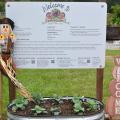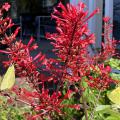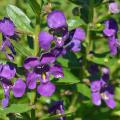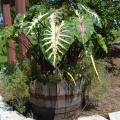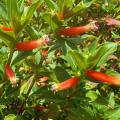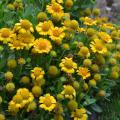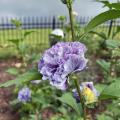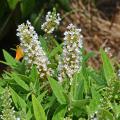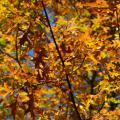News Filed Under Lawn and Garden
STARKVILLE, Miss. -- Agricultural producers and consultants are encouraged to register for the annual Mississippi State University Row Crop Short Course.
Hosted by the Mississippi State University Extension Service and the Mississippi Agricultural and Forestry Experiment Station, the 2024 Row Crop Short Course will be held Dec. 9-11 at the Mill Conference Center in Starkville.
I recently visited Rosie’s Garden in Brandon, a community space where volunteers cultivate a deeper appreciation for how food is grown while also helping to provide fresh produce to those in need.
The garden features 36 raised beds arranged in the shape of a cross, offering a diverse array of vegetable crops, herbs and flowers designed to attract pollinators.
Plants have always sparked my curiosity, and I am not alone in this. The Rankin County Master Gardeners have beautifully captured that sense of wonder with their Garden of Curiosity at the Brandon Public Library in Brandon, Mississippi.
Children’s learning gardens are a wonderful way to educate young people about plants. They are designed as places for young children to use their imaginations to relate to their surroundings, explore, touch and play as they develop an affection for the natural world. A few weeks ago, I had the pleasure of visiting the Pearl Public Library Children’s Learning Garden in Pearl, Mississippi.
I’ve always enjoyed visiting educational gardens across the state, and my recent trip to the Hill Garden in Brandon, Mississippi, was no exception.
Established by the Rankin County Master Gardeners in 1995, this garden is a treasured landmark and one of the oldest Master Gardener projects in Mississippi.
In the fall, I love driving down the road to see beautiful trees changing color as they prepare to drop their leaves for the winter. My favorite trees, however, are magnificent, fiery red maple trees. Their color stands so boldly against the yellow and brown background of the other fall colors.
This time of year, my Firespike is putting on a show in my garden. This herbaceous perennial is known for its large, dramatic spikes of bright red, tubular flowers. Each spike features densely packed clusters of 3-inch-long blooms that emerge in a striking, fiery red color, which can deepen to a rich crimson at the tips.
As summer comes to an end, the time for fall lawn care approaches. Warm-season grass growth is beginning to slow down while temperatures become slightly cooler.
On a recent visit to the Mississippi State University South Mississippi Branch Experiment Station in Poplarville, I was captivated by the beauty of the Angelonia plants in their display gardens.
The Angelonia Angelface series truly impressed me with their snapdragon-like flowers and versatility in various garden and landscape settings.
I have fond memories of walking daily as a kid past my grandmother’s chain-link fence, admiring the bright red flowers on the Turk’s Cap growing along it. Every time I see those flowers today, childhood memories rush through my mind.
Now as an adult gardener, I’ve come to appreciate Turk’s Cap even more for its beauty and resilience.
Adding a tropical feel to your garden is like creating a lush escape right at home.
With the right plants, you can transform your outdoor space into a mini paradise full of bold colors, dramatic foliage and exotic textures. Tropical plants bring a sense of adventure and tranquility, turning even the simplest garden into a getaway where you can relax and unwind.
Whether you live in a warm climate or just want to bring a bit of the tropics to your backyard, incorporating certain plants can instantly elevate the atmosphere to a unique and inviting retreat.
Next time you’re walking in the woods or in the park, take a moment to look up. If you see a tree that is over 100 ft tall, there is a good chance you are seeing a sycamore tree.
If it seems like every plant in your garden is wilting in this summer’s heat, think about adding some Vermillionaire plants next year.
I recently saw some beautiful Vermillionaire plants at the trial garden of the Mississippi State University South Mississippi Branch Experiment Station in Poplarville. These plants were thriving in the summer heat.
Floral enthusiasts and professionals can learn how to make tussie-mussie floral arrangements and the history of these bouquets during an Oct. 10 workshop in Hernando.
If you come across an enchanting, miniature landscape that captures your imagination as a world fit for fairies, then you have found a fairy garden. These tiny gardens are meticulously designed in containers, garden beds and unique spaces like old tree stumps and broken pots.
I recently visited Ross Mansion Bed and Breakfast in Hattiesburg and found some whimsical and magical fairy gardens on their property. These feature small plants, moss, pebbles and miniature accessories such as fairy houses, tiny furniture and delicate bridges.
Yellow-flowering plants have always captivated me with their bright, cheerful hues. They bring warmth and energy to the garden, instantly lifting the mood and creating a welcoming atmosphere.
Whether it’s the vibrant pop of color they add to a landscape or the way they attract pollinators with their radiant blooms, yellow flowers hold a special place in my heart.
If there’s one thing that’s important in gardening, it’s proper watering. Vegetable gardens need about 1 inch of water each week.
There is a type of plant treasured for its ability to be shared. Known as pass-along plants, these are often shared by gardeners, friends and family, typically through cuttings, divisions or seeds.
These plants carry sentimental value and foster a sense of community, as they are often passed down through generations or exchanged within local gardening groups.
I’ve always been a fan of butterfly bushes, so in my garden, I have both regular-sized varieties and a couple of dwarf varieties.
My favorites are the dwarf ones. They are compact and known for their fragrant blossoms and ability to attract pollinators such as butterflies, bees and hummingbirds.
Imagine walking through a tranquil forest in early autumn. The air is crisp, the sunlight filters softly through a canopy of vibrant leaves. Among the trees that paint this picturesque scene, one stands out with its striking, radiant colors—the pin oak.
The pin oak (Quercus palustris) is a member of the Fagaceae family, native to the central and eastern United States. Known for its distinctive pyramidal shape and slender, pin-like branches, this deciduous tree can grow up to 70 feet tall, with a spread of up to 40 feet.


